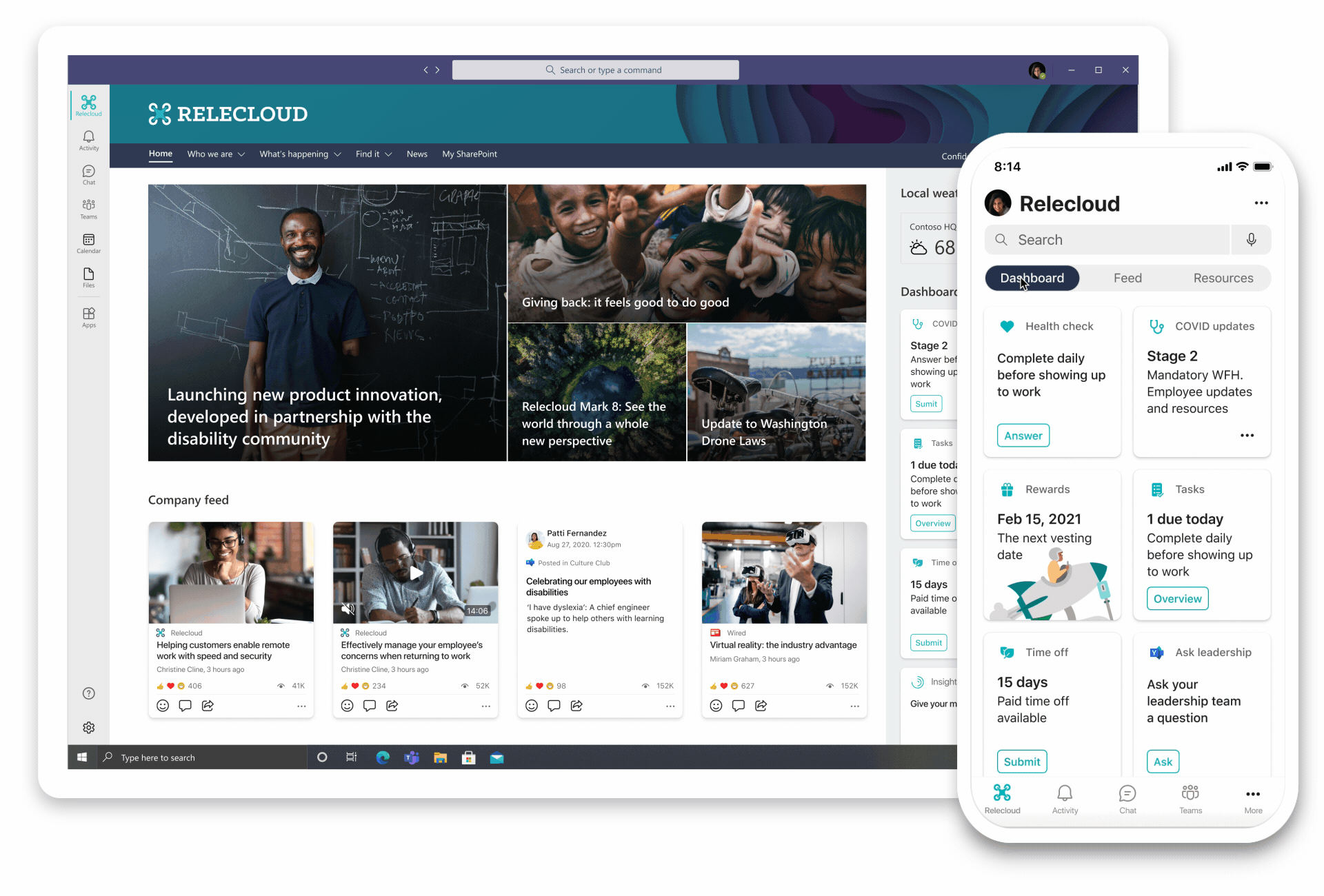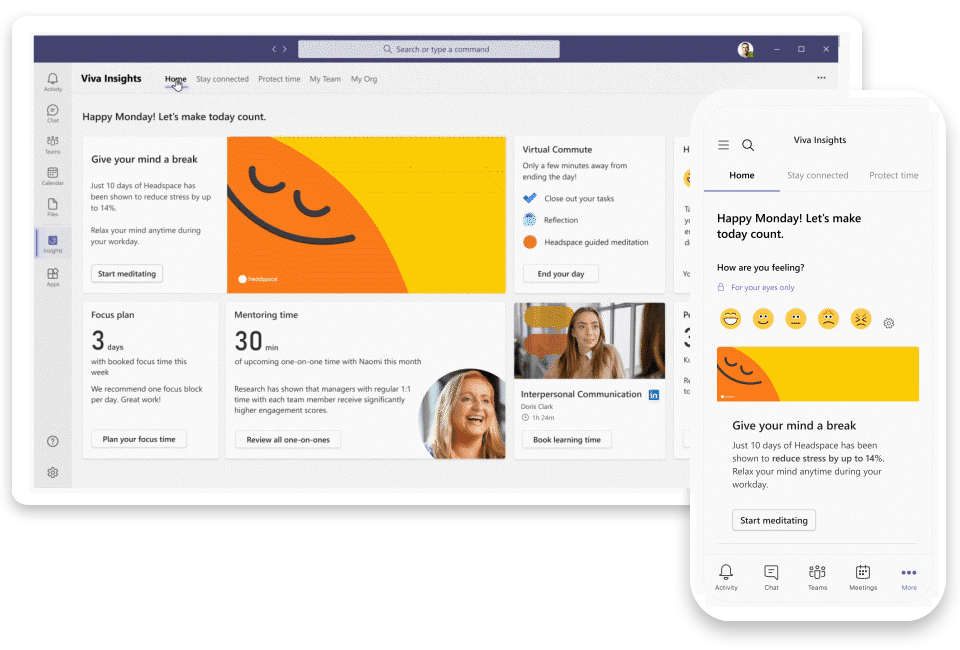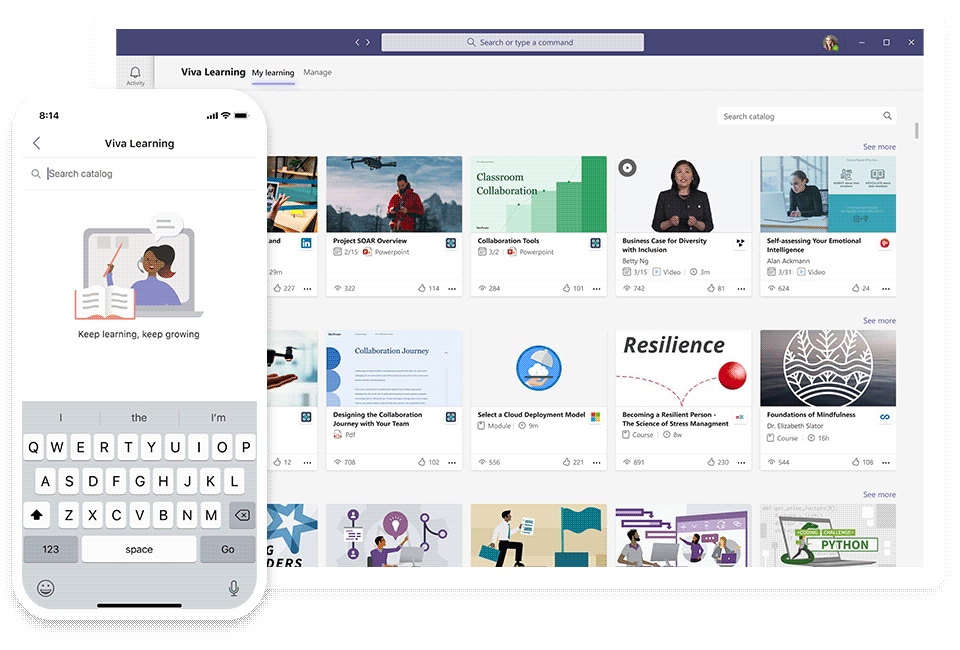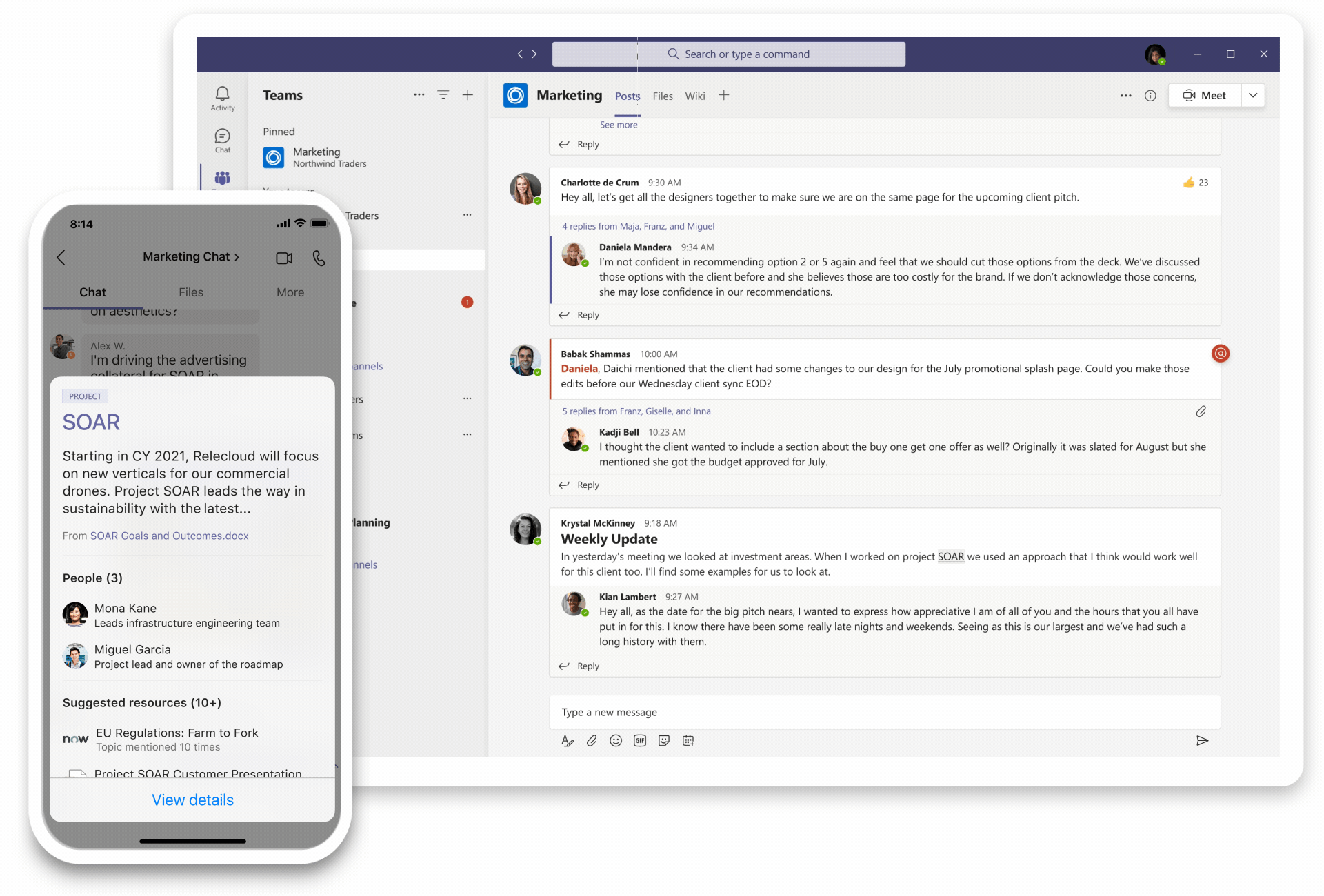Even before COVID-19 turned our lives upside down, a new generation of digital tools was opening up new possibilities for the future of work. What we didn’t expect was that this future would arrive almost overnight last March, as millions of businesses around the world responded to the pandemic by moving to remote and hybrid work.
In my role at Microsoft, I get the chance to talk to our customers every day about their experiences in this new digital era. It’s exhilarating to work on the tools that have unlocked new forms of connection and collaboration for their people—even as they navigate the challenges of the pandemic. We built Microsoft Teams and Microsoft 365 as the organizing layer for all the ways people work, learn, and collaborate. Microsoft Teams is the only solution with meetings, calls, chat, content collaboration, and business process workflows—all in a secure, integrated user experience. This fall, we saw the daily active users number in Microsoft Teams climb to 115 million, while Microsoft 365 users around the world generated more than 30 billion collaboration minutes in a single day as people communicated, collaborated, and co-authored content. And in our new hybrid work reality, Microsoft Teams is empowering everyone in organizations—from information workers to frontline workers, and everyone in between.
But to truly empower people to feel connected, supported, and able to bring their best selves to work we need to do more.
Today, organizations spend over $300 billion a year on employee experience. That number includes employee development and training, benefits and wellbeing, and a whole host of employee experience technologies. But too often, these technologies are fragmented, hard to find, and disruptive to the flow of work.
As digital tools become more crucial to a great employee experience, business leaders across every industry are embracing the opportunity to learn, and they’re re-evaluating both their spending and their approach.
We believe what’s needed is a new approach and a new category of technology solutions called employee experience platforms (EXP). In the past few months, my team and I have been talking with analyst Josh Bersin, who closely studies this space. These conversations helped solidify our vision of EXP as a digital platform that provides people with the resources and support they need, seamlessly integrated within the same tools they use to do their work, so they can succeed and thrive no matter their location.
Introducing Microsoft Viva
Today we’re introducing Microsoft Viva, the first EXP built for the digital era. Microsoft Viva brings together communications, knowledge, learning, resources, and insights into an integrated experience that empowers people and teams to be their best, from anywhere. Powered by the full breadth and depth of Microsoft 365, it is experienced through Microsoft Teams and other Microsoft 365 apps that people use every day.
A new kind of employee experience
To start, Microsoft Viva will include four modules: Viva Connections, Viva Insights, Viva Learning, and Viva Topics—with more on the way. I’ll walk you through each one.
Let’s begin with Viva Connections.
Research from our Work Trend Index shows nearly 60 percent of workers feel less connected to their team since the move to remote work. And we’re struggling to replace the comradery once created by things like company town halls, offsites, and events. This is challenging for all of us, but especially impactful on new hires—imagine how it feels for an employee who has never been to the office or ever met anyone face-to-face.
Accessed in Microsoft Teams, Viva Connections provides a single-entry point for employee engagement and internal communications. You can think of it as a gateway to your digital workplace.
Viva Connections is built on Microsoft 365 capabilities like SharePoint to provide a curated and branded employee destination. Leaders can connect with employees via company town halls, and employees can access everything from company news, policies, and benefits to employee resource groups or communities they want to join with Microsoft Viva’s integration to Yammer. It provides a personalized feed and dashboard to help you find all the helpful resources you need from Microsoft Viva and from other apps across your digital workplace. The content can also be customized for specific roles within the company—including frontline workers—so that they have a comprehensive view of just the resources they need.

Next, Viva Insights.
At a time when over 30 percent of workers say the pandemic has increased their sense of burnout, it has never been more important to help people unplug and make the most of their scarcest resource: their time.
Viva Insights gives individuals, managers, and leaders personalized and actionable privacy-protected insights that help everyone in an organization thrive. It brings new personal wellbeing experiences, insights, and recommended actions from Workplace Analytics and MyAnalytics into the flow of people’s work in Microsoft Teams.
Accessed in Microsoft Teams, Viva Insights for individuals help employees stay connected with their colleagues and protect time for regular breaks, focused work, and learning. Experiences we announced last summer, like virtual commute and integration with Headspace, kickstarted our work here. They will now be part of Microsoft Viva and will start rolling out in the coming months.
For managers, Viva Insights provides data-driven, privacy-protected insights and recommendations to foster healthy, successful teams. For instance, Viva Insights can help a manager see if their team is at risk of burnout and provide recommendations like encouraging your team to turn off notifications, set boundaries in their calendar, and set daily priorities to focus on what matters most.
For company leaders, Viva Insights helps address complex challenges and respond to change by shedding light on organizational work patterns and trends. These could include wellbeing opportunities, but also things like space planning as companies reimagine their offices for hybrid work. Viva Insights also provides leaders with organizational network analysis to understand the connectedness and cohesion between and across teams.
These organizational insights are even more powerful when combined with other data sources. Today, we’re excited to introduce a new dashboard for Microsoft Viva and LinkedIn’s Glint customers that maps insights about how people work to employee survey data about how people feel. In addition to using data and signals from Microsoft apps and services, Microsoft Viva builds on an organization’s existing investments. A customer can also leverage data from third-party tools like Zoom, Slack, Workday, and SAP SuccessFactors.
To help ensure privacy and security, Microsoft Viva uses aggregation, de-identification, and differential privacy. This means personal insights are visible only to the employee, while insights for managers and leaders are aggregated and de-identified by default to protect individual privacy.

Now onto Viva Learning.
Organizations need to develop a culture of learning to keep up with the pace of change and to retain great talent. Specifically, a recent report from LinkedIn found that 94 percent of employees would stay at a company longer if it invested in their learning and development.
Viva Learning helps make learning a natural part of both every employee’s daily work and company culture.
With Viva Learning, employees can easily discover and share everything from training courses to microlearning content. And managers get the tools they need to assign learning and to track the completion of courses to help foster a learning culture. Viva Learning creates a central hub for learning in Teams, with AI that recommends the right content at the right time. It aggregates content from LinkedIn Learning, Microsoft Learn, your organization’s own custom content, and trainings from leading content providers like Skillsoft, Coursera, Pluralsight, and edX. Viva Learning also works with leading learning-management systems. Today we’re announcing partnerships with Cornerstone OnDemand, Saba, and SAP SuccessFactors. And there are more are on the way.

Finally, Viva Topics.
As we have all experienced, finding an expert, understanding company acronyms, or surfacing the content you need can be tedious, especially when you’re a new employee or working remotely. In fact, our research shows that people spend the equivalent of seven weeks per year searching for or re-creating information.
Viva Topics enables you to harness the knowledge of your organization, and connect people to that knowledge, in the apps they use every day. Think of Viva Topics as a Wikipedia with AI superpowers for your organization. It uses AI to automatically organize company-wide content and expertise into relevant categories like “projects,” “products,” “processes,” and “customers.”
When you come across an unfamiliar topic or acronym, just hover. No need to search for knowledge—knowledge finds you. Viva Topics automatically surfaces topic cards as people work in apps like Office, SharePoint, and Microsoft Teams. When employees click on a card, a topic page appears with documents, videos, and related people. Experts at the company can also help curate the information shown in Viva Topics by sharing knowledge through simple, highly customizable web sites called Topic Pages.
Along with content from the Microsoft Cloud, Viva Topics also surfaces information from third-party services like ServiceNow and Salesforce and builds on integrations made by partners like Accenture, Avanade, BA Insight, Raytion, and ClearPeople. And Graph connectors make it easy to connect to even more content that employees would find helpful.

Together with our partners
Designed to be an open and extensible platform, with a strong and growing ecosystem of partners, Microsoft Viva is easy to integrate with the systems and tools a company already has in place. Integrations with Microsoft 365, Microsoft Power Platform, Microsoft Dynamics 365, and third-party products and services will deliver a complete employee experience in the flow of work. In addition to our integration ecosystem, we’re joined in this mission by our global network of services partners who provide strategic guidance, advisory services, implementation, adoption and change management, and more.
You can hear from some of our partners in this video:
Just getting started
We all know that engaged, healthy employees who feel a sense of ownership, purpose, and belonging have a greater impact on our organizations. And at Microsoft, we’re committed to helping our customers empower all their people, whether they’re working onsite, in the field, at home, or on the go. Today, we begin the journey of creating an entirely new employee experience designed for the digital era.
With Microsoft Viva, we aim to make it easier and more natural for everyone to stay connected, access knowledge, learn on the job, and use privacy-protected insights—to enable individuals to prioritize wellbeing, empower managers to lead more effectively, and help leaders drive better decision-making across the organization. But while we’re so excited to introduce you to Microsoft Viva today, there’s so much more to come. We believe this is a once-in-a-lifetime opportunity to build people-centered experiences that help our customers drive extraordinary outcomes. And we’re just getting started.
Experience Microsoft Viva today
Want to help your people experience Microsoft Viva right away? As of today, Viva Topics is generally available. We’re also announcing the public preview of Viva Insights and a private preview of Viva Learning. And we’ll be announcing more innovations throughout 2021. To learn more and get started, check out the Microsoft Viva website.
The post Microsoft Viva: Empowering every employee for the new digital age appeared first on Microsoft 365 Blog.
Source: Office Blog
—